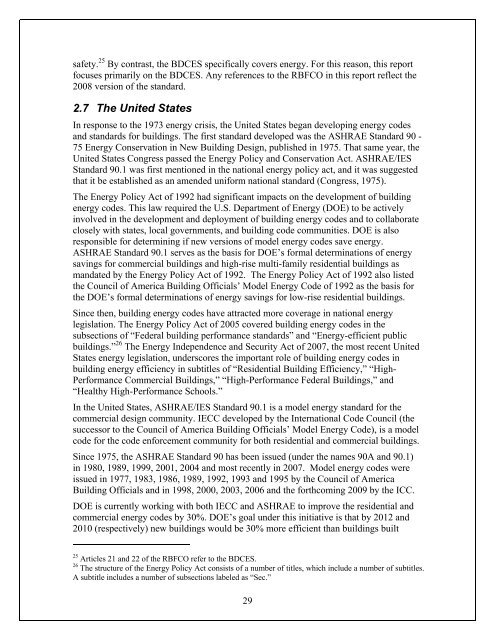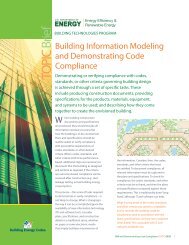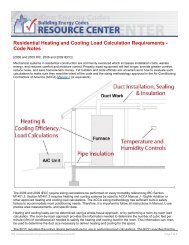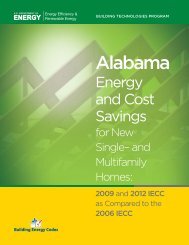(DCGREUH) issued by <strong>the</strong> M<strong>in</strong>istry of Construction <strong>in</strong> 1980 and later revised <strong>in</strong> 1992,1999, 2003, 2006 and 2008; and 2) Criteria for Clients on <strong>the</strong> Rationalization of <strong>Energy</strong>Use for Houses (CCREUH) issued by <strong>the</strong> M<strong>in</strong>istry of International Trade and Industryand <strong>the</strong> M<strong>in</strong>istry of Construction <strong>in</strong> 1980 and later revised several times between 1992and 2008.2.6 South KoreaIn <strong>the</strong> wake of <strong>the</strong> oil crisis <strong>in</strong> <strong>the</strong> 1970s, South Korea established <strong>the</strong> M<strong>in</strong>istry of Powerand Resources. The government <strong>the</strong>n issued <strong>the</strong> Rational <strong>Energy</strong> Utilization Act <strong>in</strong> 1979as a national law for energy efficiency and conservation. It also established <strong>the</strong> Korean<strong>Energy</strong> Management Corporation <strong>in</strong> 1980 to manage national energy efficiency programsand policies issued by Rational <strong>Energy</strong> Utilization Act (Ahn, 1998).Recogniz<strong>in</strong>g that its economy is largely fueled by imported fossil fuels, South Korea hasset <strong>the</strong> three E’s (energy security of supply, economic efficiency and environmentalprotection) as its national goals for achiev<strong>in</strong>g susta<strong>in</strong>able economic development. TheM<strong>in</strong>istry of Knowledge Economy (formerly <strong>the</strong> M<strong>in</strong>istry of Commerce, Industry and<strong>Energy</strong> 24 ) is <strong>in</strong> charge of national energy policy.From <strong>the</strong> mid-1970s to <strong>the</strong> mid-1990s, South Korea focused on improv<strong>in</strong>g energyefficiency <strong>in</strong> <strong>the</strong> <strong>in</strong>dustrial sector. S<strong>in</strong>ce <strong>the</strong> late 1990s, <strong>the</strong> government has promotedenergy efficiency <strong>in</strong> <strong>the</strong> build<strong>in</strong>gs and transportation sectors (Hong et al. 2007). Forexample, <strong>the</strong> government is prepar<strong>in</strong>g new, long-term energy conservation goals for <strong>the</strong>build<strong>in</strong>gs sector. These goals are currently anticipated to reduce emissions by 30% <strong>in</strong> thissector by 2030, as compared with bus<strong>in</strong>ess-as-usual emissions.South Korea issued its first mandatory build<strong>in</strong>g standard on <strong>in</strong>sulation thickness <strong>in</strong> 1977,followed by build<strong>in</strong>g energy standards for several types of build<strong>in</strong>gs <strong>in</strong> <strong>the</strong> next twodecades. These standards covered offices, hotels, hospitals and residential build<strong>in</strong>gs.These <strong>in</strong>dividual standards were <strong>in</strong>tegrated <strong>in</strong>to <strong>the</strong> BDCES <strong>in</strong> 2001, which is mandatoryfor all types of residential and commercial build<strong>in</strong>gs where high energy consumption isexpected. Major revisions to BDCES were issued <strong>in</strong> 2003 (<strong>in</strong>corporated diverse highefficiencyappliances), 2004 (<strong>in</strong>corporated new technologies) and 2008 (<strong>in</strong>corporatedrenewable technologies and revised <strong>in</strong>centive structure for voluntary standards).The BDCES was a product of <strong>in</strong>tensive revision of exist<strong>in</strong>g standards and review ofbuild<strong>in</strong>g energy codes of several countries <strong>in</strong>clud<strong>in</strong>g <strong>the</strong> United States, <strong>the</strong> UnitedK<strong>in</strong>gdom, Germany, Japan and Canada. The South Korean government felt that complexcodes like those <strong>in</strong> <strong>the</strong> United States may provide detailed rules but it preferred a simpleapproach to ease implementation <strong>in</strong> South Korea (Lee 2006). The BDCES underwentseveral revisions after 2001; <strong>the</strong> latest occurred <strong>in</strong> November 2008. This report reflects<strong>the</strong> November 2008 version of <strong>the</strong> standard.The BDCES and <strong>the</strong> RBFCO represent different types of sub-regulations under <strong>the</strong>framework of <strong>the</strong> Build<strong>in</strong>g Act. The RBFCO, first implemented <strong>in</strong> 1992, conta<strong>in</strong>sprescriptive requirements for <strong>in</strong>sulation, but also for construction more broadly, <strong>in</strong>clud<strong>in</strong>g24 The M<strong>in</strong>istry of <strong>Energy</strong> and Resources was established <strong>in</strong> 1978 after <strong>the</strong> oil crisis and later <strong>in</strong>tegrated <strong>in</strong>to<strong>the</strong> M<strong>in</strong>istry of Commerce, Industry and <strong>Energy</strong>.28
safety. 25 By contrast, <strong>the</strong> BDCES specifically covers energy. For this reason, this reportfocuses primarily on <strong>the</strong> BDCES. Any references to <strong>the</strong> RBFCO <strong>in</strong> this report reflect <strong>the</strong>2008 version of <strong>the</strong> standard.2.7 The United StatesIn response to <strong>the</strong> 1973 energy crisis, <strong>the</strong> United States began develop<strong>in</strong>g energy codesand standards for build<strong>in</strong>gs. The first standard developed was <strong>the</strong> ASHRAE Standard 90 -75 <strong>Energy</strong> Conservation <strong>in</strong> <strong>New</strong> Build<strong>in</strong>g Design, published <strong>in</strong> 1975. That same year, <strong>the</strong>United States Congress passed <strong>the</strong> <strong>Energy</strong> Policy and Conservation Act. ASHRAE/IESStandard 90.1 was first mentioned <strong>in</strong> <strong>the</strong> national energy policy act, and it was suggestedthat it be established as an amended uniform national standard (Congress, 1975).The <strong>Energy</strong> Policy Act of 1992 had significant impacts on <strong>the</strong> development of build<strong>in</strong>genergy codes. This law required <strong>the</strong> U.S. Department of <strong>Energy</strong> (DOE) to be actively<strong>in</strong>volved <strong>in</strong> <strong>the</strong> development and deployment of build<strong>in</strong>g energy codes and to collaborateclosely with states, local governments, and build<strong>in</strong>g code communities. DOE is alsoresponsible for determ<strong>in</strong><strong>in</strong>g if new versions of model energy codes save energy.ASHRAE Standard 90.1 serves as <strong>the</strong> basis for DOE’s formal determ<strong>in</strong>ations of energysav<strong>in</strong>gs for commercial build<strong>in</strong>gs and high-rise multi-family residential build<strong>in</strong>gs asmandated by <strong>the</strong> <strong>Energy</strong> Policy Act of 1992. The <strong>Energy</strong> Policy Act of 1992 also listed<strong>the</strong> Council of America Build<strong>in</strong>g Officials’ Model <strong>Energy</strong> Code of 1992 as <strong>the</strong> basis for<strong>the</strong> DOE’s formal determ<strong>in</strong>ations of energy sav<strong>in</strong>gs for low-rise residential build<strong>in</strong>gs.S<strong>in</strong>ce <strong>the</strong>n, build<strong>in</strong>g energy codes have attracted more coverage <strong>in</strong> national energylegislation. The <strong>Energy</strong> Policy Act of 2005 covered build<strong>in</strong>g energy codes <strong>in</strong> <strong>the</strong>subsections of “Federal build<strong>in</strong>g performance standards” and “<strong>Energy</strong>-efficient publicbuild<strong>in</strong>gs.” 26 The <strong>Energy</strong> Independence and Security Act of 2007, <strong>the</strong> most recent UnitedStates energy legislation, underscores <strong>the</strong> important role of build<strong>in</strong>g energy codes <strong>in</strong>build<strong>in</strong>g energy efficiency <strong>in</strong> subtitles of “Residential Build<strong>in</strong>g <strong>Efficiency</strong>,” “High-Performance Commercial Build<strong>in</strong>gs,” “High-Performance Federal Build<strong>in</strong>gs,” and“Healthy High-Performance Schools.”In <strong>the</strong> United States, ASHRAE/IES Standard 90.1 is a model energy standard for <strong>the</strong>commercial design community. IECC developed by <strong>the</strong> International Code Council (<strong>the</strong>successor to <strong>the</strong> Council of America Build<strong>in</strong>g Officials’ Model <strong>Energy</strong> Code), is a modelcode for <strong>the</strong> code enforcement community for both residential and commercial build<strong>in</strong>gs.S<strong>in</strong>ce 1975, <strong>the</strong> ASHRAE Standard 90 has been issued (under <strong>the</strong> names 90A and 90.1)<strong>in</strong> 1980, 1989, 1999, 2001, 2004 and most recently <strong>in</strong> 2007. Model energy codes wereissued <strong>in</strong> 1977, 1983, 1986, 1989, 1992, 1993 and 1995 by <strong>the</strong> Council of AmericaBuild<strong>in</strong>g Officials and <strong>in</strong> 1998, 2000, 2003, 2006 and <strong>the</strong> forthcom<strong>in</strong>g 2009 by <strong>the</strong> ICC.DOE is currently work<strong>in</strong>g with both IECC and ASHRAE to improve <strong>the</strong> residential andcommercial energy codes by 30%. DOE’s goal under this <strong>in</strong>itiative is that by 2012 and2010 (respectively) new build<strong>in</strong>gs would be 30% more efficient than build<strong>in</strong>gs built25 Articles 21 and 22 of <strong>the</strong> RBFCO refer to <strong>the</strong> BDCES.26 The structure of <strong>the</strong> <strong>Energy</strong> Policy Act consists of a number of titles, which <strong>in</strong>clude a number of subtitles.A subtitle <strong>in</strong>cludes a number of subsections labeled as “Sec.”29
- Page 1 and 2: PNNL-122267Shaping the Energy Effic
- Page 3: Shaping the Energy Efficiency in Ne
- Page 6 and 7: efficient air conditioning system,
- Page 8 and 9: ContentsForeword ..................
- Page 10 and 11: List of TablesTable 1 GDP, Primary
- Page 12 and 13: ForewordBuildings account for about
- Page 14 and 15: 1 Introduction and Background1.1 Im
- Page 16 and 17: esidential buildings in 2006, with
- Page 18 and 19: JAP 1. Criteria for Clients on the
- Page 20 and 21: can significantly increase energy d
- Page 22 and 23: f) South Korea’s building energy
- Page 24 and 25: 2.1 AustraliaIn the past, Australia
- Page 26 and 27: small cities will be pilot of such
- Page 30 and 31: according to the current codes. Thi
- Page 32 and 33: Table 7 Structural Comparison of Bu
- Page 34 and 35: 3.3 Building EnvelopeKey Findings A
- Page 36 and 37: JAPCCREUH1999KORBDCES2008USAASHRAE9
- Page 38 and 39: This study selects the midpoint sco
- Page 40 and 41: MiamiUSA0.36(Insulationabove deck)t
- Page 42 and 43: Six countries have jurisdictions in
- Page 44 and 45: thermal requirements for roofs, flo
- Page 46 and 47: Figure 6 Maximum U-factors in Resid
- Page 48 and 49: Table 16 HVAC in Japan’s Building
- Page 50 and 51: ItemsService water heating refers t
- Page 52 and 53: Water conservation Canada has manda
- Page 54 and 55: practice (MNECB 1997). India sets m
- Page 56 and 57: Canada and India adopt compliance p
- Page 58 and 59: Japan only supervises the building
- Page 60 and 61: 4.2 Testing and RatingKey Findings
- Page 62 and 63: Other commonly used tools among APP
- Page 64 and 65: CAN 55MNECH1997CHNINDECBCJAPCanadia
- Page 66 and 67: and local jurisdiction contact info
- Page 68 and 69: certifying third-party verifiers or
- Page 70 and 71: Point of ControlIncentives for Comp
- Page 72 and 73: Point of ControlIncentives for Comp
- Page 74 and 75: AUS,continuedCANTesting Agencies an
- Page 76 and 77: CAN,continuedCHNTesting Agencies an
- Page 78 and 79:
Testing Agencies and Certification
- Page 80 and 81:
USA,continuedTesting Agencies and C
- Page 82 and 83:
Appendix C - Compliance SoftwareAUS
- Page 84 and 85:
CANMNECB1997,continuedSoftwareMetho
- Page 86 and 87:
USAIECC 2006,continuedSoftwareMetho
- Page 88 and 89:
AUSBCA 2007,continuedCANMNECB1997CA
- Page 90 and 91:
JAP,ContinuedKORUSAASHRAE90.1-2007T
- Page 92 and 93:
AcronymsAPPAS/NZSASHRAEAUSBATFBCABD
- Page 94 and 95:
ReferencesABCB (Australian Building
- Page 96 and 97:
IEA (International Energy Agency).
- Page 98:
OEE. 2008. Energy Use Data Handbook
















